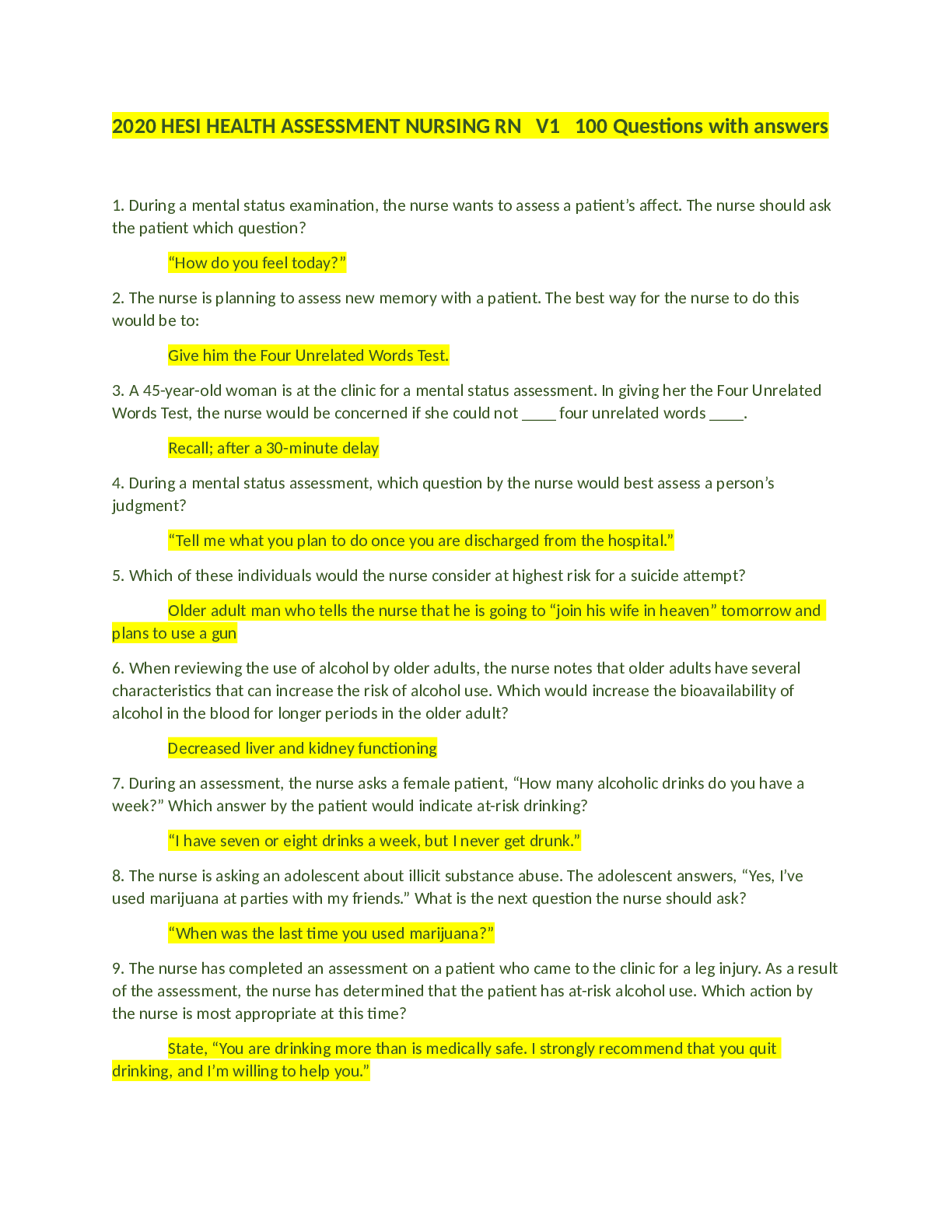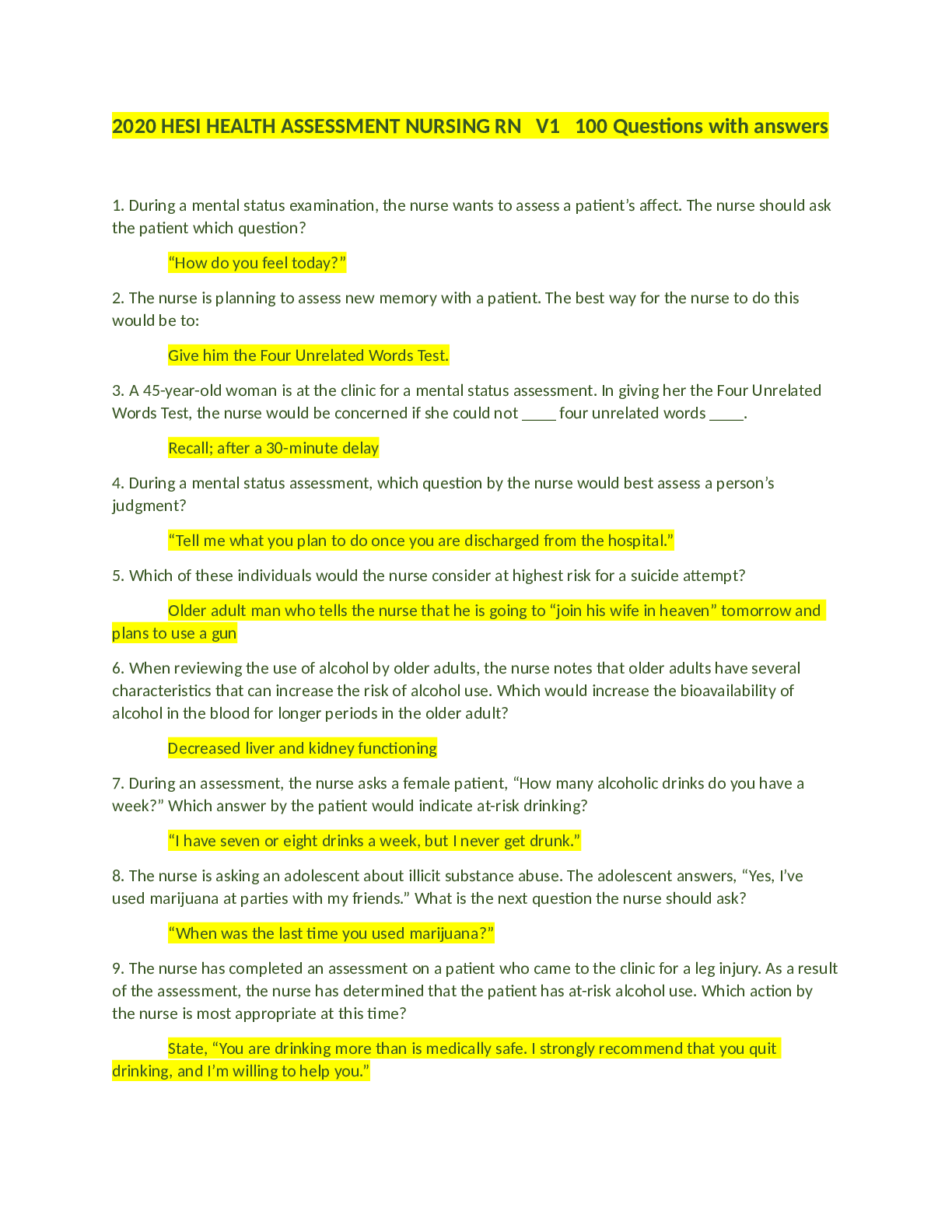2020 HESI HEALTH ASSESSMENT NURSING RN V1 100 Questions with answers
1. During a mental status examination, the nurse wants to assess a patient’s affect. The nurse should ask
the patient which question?
“How do you feel today?”
2. The nurse is planning to assess new memory with a patient. The best way for the nurse to do this
would be to:
Give him the Four Unrelated Words Test.
3. A 45-year-old woman is at the clinic for a mental status assessment. In giving her the Four Unrelated
Words Test, the nurse would be concerned if she could not ____ four unrelated words ____.
Recall; after a 30-minute delay
4. During a mental status assessment, which question by the nurse would best assess a person’s
judgment?
“Tell me what you plan to do once you are discharged from the hospital.”
5. Which of these individuals would the nurse consider at highest risk for a suicide attempt?
Older adult man who tells the nurse that he is going to “join his wife in heaven” tomorrow and
plans to use a gun
6. When reviewing the use of alcohol by older adults, the nurse notes that older adults have several
characteristics that can increase the risk of alcohol use. Which would increase the bioavailability of
alcohol in the blood for longer periods in the older adult?
Decreased liver and kidney functioning
7. During an assessment, the nurse asks a female patient, “How many alcoholic drinks do you have a
week?” Which answer by the patient would indicate at-risk drinking?
“I have seven or eight drinks a week, but I never get drunk.”
8. The nurse is asking an adolescent about illicit substance abuse. The adolescent answers, “Yes, I’ve
used marijuana at parties with my friends.” What is the next question the nurse should ask?
“When was the last time you used marijuana?”
9. The nurse has completed an assessment on a patient who came to the clinic for a leg injury. As a result
of the assessment, the nurse has determined that the patient has at-risk alcohol use. Which action by
the nurse is most appropriate at this time?
State, “You are drinking more than is medically safe. I strongly recommend that you quit
drinking, and I’m willing to help you.”10. A patient is brought to the emergency department. He is restless, has dilated pupils, is sweating, has
a runny nose and tearing eyes, and complains of muscle and joint pains. His girlfriend thinks he has
influenza, but she became concerned when his temperature went up to 39.4° C. She admits that he has
been a heavy drug user, but he has been trying to stop on his own. The nurse suspects that the patient is
experiencing withdrawal symptoms from which substance?
Heroin
11. Patient taking ipratropium reports nausea, blurred vision, has, insomnia after using the inhaler. RN
action to implement
- withhold med and report symptoms
12. A patient has suddenly developed shortness of breath and appears to be in significant respiratory
distress. After calling the physician and placing the patient on oxygen, which of these actions is the best
for the nurse to take when further assessing the patient?
Bilaterally percuss the thorax, noting any differences in percussion tones.
13. The nurse is teaching a class on basic assessment skills. Which of these statements is true regarding
the stethoscope and its use?
Although the stethoscope does not magnify sound, it does block out extraneous room noise.
14. The nurse is preparing to use a stethoscope for auscultation. Which statement is true regarding the
diaphragm of the stethoscope? The diaphragm:
Is used to listen for high-pitched sounds.
15. Before auscultating the abdomen for the presence of bowel sounds on a patient, the nurse should:
Check the temperature of the room, and offer blankets to the patient if he or she feels cold.
16. While measuring a patient’s blood pressure, the nurse recalls that certain factors, such as
__________, help determine blood pressure.
Peripheral vascular resistance
17. A nurse is helping at a health fair at a local mall. When taking blood pressures on a variety of people,
the nurse keeps in mind that:
The blood pressure of a Black adult is usually higher than that of a White adult of the same age.
8. The nurse notices a colleague is preparing to check the blood pressure of a patient who is obese by
using a standard-sized blood pressure cuff. The nurse should expect the reading to:
Yield a falsely high blood pressure.
19. A student is late for his appointment and has rushed across campus to the health clinic. The nurse
should:
Allow 5 minutes for him to relax and rest before checking his vital signs.20. Hypoptysis (new cough) or changes in persistent cough
tuberculosis s/sx
21. The nurse is assessing a patient’s pain. The nurse knows that the most reliable indicator of pain
would be the:
Subjective report.
22. A patient has had arthritic pain in her hips for several years since a hip fracture. She is able to move
around in her room and has not offered any complaints so far this morning. However, when asked, she
states that her pain is “bad this morning” and rates it at an 8 on a 1-to-10 scale. What does the nurse
suspect? The patient:
Has experienced chronic pain for years and has adapted to it.
23. The nurse is reviewing the principles of pain. Which type of pain is due to an abnormal processing of
the pain impulse through the peripheral or central nervous system?
Neuropathic
24. The nurse hears bilateral loud, long, and low tones when percussing over the lungs of a 4-year-old
child. The nurse should:
Consider this finding as normal for a child this age, and proceed with the examination.
25. When assessing the quality of a patient’s pain, the nurse should ask which question?
“What does your pain feel like?”
26. When assessing a patient’s pain, the nurse knows that an example of visceral pain would be:
Cholecystitis.
27. A 75-year-old woman who has a history of diabetes and peripheral vascular disease has been trying
to remove a corn on the bottom of her foot with a pair of scissors. The nurse will encourage her to stop
trying to remove the corn with scissors because:
The woman could be at increased risk for infection and lesions because of her chronic disease.
28. The nurse keeps in mind that a thorough skin assessment is extremely important because the skin
holds information about a person’s:
Circulatory status.
29. A patient comes in for a physical examination and complains of “freezing to death” while waiting for
her examination. The nurse notes that her skin is pale and cool and attributes this finding to:
Peripheral vasoconstriction.
30. A patient comes to the clinic and tells the nurse that he has been confined to his recliner chair for
approximately 3 days with his feet down and he asks the nurse to evaluate his feet. During the
assessment, the nurse might expect to find:Caused by the complete absence of melanin pigment
31.The nurse will perform a palpated pressure before auscultating blood pressure. The reason for this is
to:
Detect the presence of an auscultatory gap.
32. A patient tells the nurse that he has noticed that one of his moles has started to burn and bleed.
When assessing his skin, the nurse pays special attention to the danger signs for pigmented lesions and is
concerned with which additional finding?
Color variation
33. sarcoidosis - autoimmune inflammatory disease affecting multiple organs
- improved pulse oximetry values
34. A 19-year-old college student is brought to the emergency department with a severe headache he
describes as, “Like nothing I’ve ever had before.” His temperature is 40° C, and he has a stiff neck. The
nurse looks for other signs and symptoms of which problem?
Meningeal inflammation
35. During a well-baby checkup, the nurse notices that a 1-week-old infant’s face looks small compared
with his cranium, which seems enlarged. On further examination, the nurse also notices dilated scalp
veins and downcast or “setting sun” eyes. The nurse suspects which condition?
Hydrocephalus
36. The nurse needs to palpate the temporomandibular joint for crepitation. This joint is located just
below the temporal artery and anterior to the:
Tragus.
37. A patient has come in for an examination and states, “I have this spot in front of my ear lobe on my
cheek that seems to be getting bigger and is tender. What do you think it is?” The nurse notes swelling
below the angle of the jaw and suspects that it could be an inflammation of his:
Parotid gland.
38. A male patient with a history of acquired immunodeficiency syndrome (AIDS) has come in for an
examination and he states, “I think that I have the mumps.” The nurse would begin by examining the:
Parotid gland.
39. In performing an examination of a 3-year-old child with a suspected ear infection, the nurse would:
Perform the otoscopic examination at the end of the assessment.
40. The nurse is preparing to perform an otoscopic examination of a newborn infant. Which statement is
true regarding this examination?The normal membrane may appear thick and opaque.
41. The nurse assesses the hearing of a 7-month-old by clapping hands. What is the expected response?
The infant:
Turns his or her head to localize the sound.
42. The nurse is performing an ear exami
Read More


